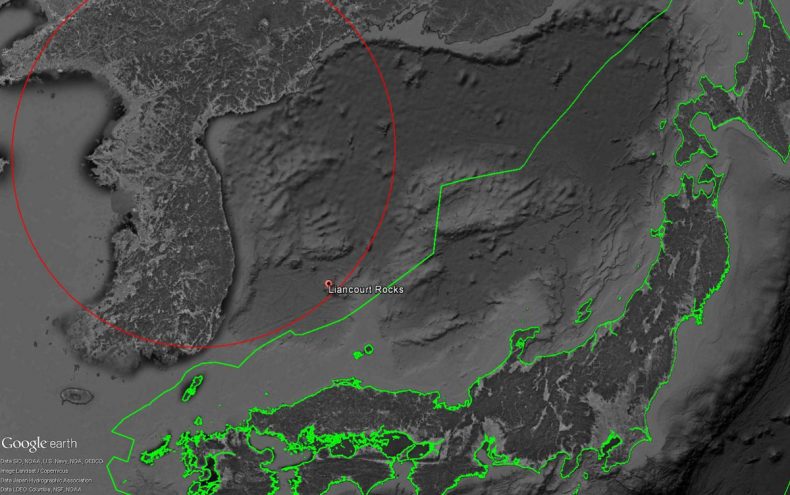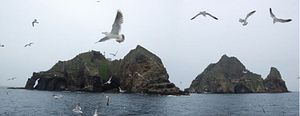On Monday, North Korea launched what the United States, South Korea, and Japan assessed to be a short-range ballistic missile — likely one of its Scuds. The missile was launched from Wonsan and flew for 450 kilometers on a eastward trajectory, landing in the Sea of Japan. The test is the third ballistic missile test from North Korea in three weeks, coming in the wake of Pyongyang’s first-ever test of the Hwasong-12 intermediate-range ballistic missile and the second test of the Pukkuksong-2 solid-fuel medium-range ballistic missile.
Sunday’s test drew a sharp reaction from Japan, which claimed that the missile had landed in its exclusive economic zone. Chief Cabinet Secretary Yoshihide Suga told reporters early on Monday, shortly after the launch was confirmed, that the missile was “believed to have landed in Japan’s exclusive economic zone.”
In March, when North Korea carried out a salvo launch of four extended-range (ER) Scuds, three projectiles landed in Japan’s EEZ. Moreover, last year, a North Korean Nodong landed in Japan’s EEZ for the first time ever. Japanese Prime Minister Shinzo Abe vowed to take “concrete measures” in response to the launch; Tokyo has mulled open intercept orders for North Korean test projectiles and began civilian ballistic missile attack evacuation exercises for the first time this year.

A map of the Sea of Japan, showing Japan’s exclusive economic zone without the inclusion of the disputed Liancourt Rocks, which are administered by South Korea as Dokdo. Red shows a range of 450 kilometers from Wonsan, where North Korea launched a missile on Monday. (Source: Google Earth, Marine Regions)
As Jeffrey Lewis first observed, the given flight range of 450 kilometers and Japan’s claim that the projectile splashed down in its EEZ can only be reconciled if one concedes Tokyo’s claim to the Liancourt Rocks (known as Dokdo in South Korea and Takeshima in Japan). The Dokdo/Takeshima dispute continues to be a sore spot in relations between Seoul and Tokyo, both of whom claim sovereignty over the features. South Korea administers the islands, but Japan claims them as part of its territory and, accordingly, claims an extended 200 nautical mile EEZ off the features. Thus, the only way a 450 kilometer ranged ballistic missile from Wonsan could land in Japan’s EEZ is if the EEZ is extended from around the disputed islands.
There’s good reason to think that North Korea may have been deliberately attempting to prod this sore point between two U.S. allies. First, North Korea’s short-range, liquid-fuel Scud-type missiles are by far its most reliable and well-tested set of projectiles. Pyongyang usually fires a single Scud — as it did twice out of Sinpo in April — for developmental purposes. If the Scud fired out of Wonsan on Monday wasn’t something unusual, like the still-in-development Scud-based anti-ship missile, then the launch may likely have been meant more for signaling or as a user trial. (North Korea additionally hasn’t conducted any known Scud tests or launches out of Wonsan since 2014.)
Second, exploiting a gap between Japan and South Korea weeks after the inauguration of a new president in Seoul makes sense for Pyongyang. South Korean President Moon Jae-in wasted little time after entering office; he immediately got on the phone with U.S. President Donald J. Trump, Chinese President Xi Jinping, and Japanese Prime Minister Shinzo Abe to discuss the North Korean issue. Anything North Korea can do to disrupt regional coordination and communication over its ballistic missile and nuclear weapon programs is to its benefit.
Moreover, trilateral coordination on missile defense and intelligence-sharing on North Korea continues between the United States, South Korea, and Japan. Japan publicly claiming that a missile landed in its EEZ off Dokdo could harm this momentum, amplifying burgeoning signs of alliance stress between Seoul and Washington as well. While Suga presumably took North Korea’s bait by immediately claiming that the missile landed in Japan’s EEZ on Monday, South Korea has yet to respond publicly to Tokyo’s claim, suggesting that Seoul may be one step ahead of Pyongyang’s intentions with Monday’s launch. (South Korea may be taking up the issue with Japan through more discreet channels.)
For additional context, consider that North Korean state media, earlier this year, strongly criticized Japan after Foreign Minister Fumio Kishida claimed the disputed isles. Moreover, just more than a week ago, South Korea rebuffed complaints from the Japanese government over its marine research around Dokdo. Tokyo asserted that South Korea should have requested prior permission to carry out marine research in its EEZ. Cho June-hyuck, a South Korean foreign ministry spokesman, said “Our stance is that we will sternly respond to Japan’s unjust claims to our inherent territory,” he told reporters. “There is no need for us to ask for prior admission, and we don’t have to do such a thing.” North Korea may have sensed an opportunity with another flare-up of the dispute so early in Moon’s term.
Finally, after the North Korean launch, U.S. President Donald J. Trump managed to ignore both Northeast Asian U.S. allies in a short statement he released on Twitter about the launch, instead discussing how North Korea had shown disrespect for China by carrying out a ballistic missile launch: “North Korea has shown great disrespect for their neighbor, China, by shooting off yet another ballistic missile…but China is trying hard!” As I’ve explained before, the United States is very unlikely to wade into the Dokdo/Takeshima dispute to avoid having to mediate between its allies. The Trump administration isn’t likely to break with that tradition.
Ultimately, if North Korea was intentionally seeking to drive a wedge between Seoul and Tokyo over the disputed islands, it hasn’t succeeded in that endeavor just yet. Much will depend on whether and how Seoul chooses to push back on Tokyo’s assertion.

































